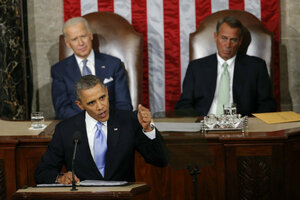#SOTU2015: How Obama is taking a centuries-old tradition into the Twitter age
The president is once more turning to social media as he tries to focus his messaging to Americans.

Vice President Joe Biden and House Speaker John Boehner of Ohio listens as President Barack Obama gives his State of the Union address on Jan. 28, 2014 on Capitol Hill in Washington.
Charles Dharapak/AP Photo/File
Step aside, mainstream media – social is where it’s at.
That, reports say, is the idea propelling the public relations build-up to President Obama’s State of the Union address this year: By the time he takes the stage Tuesday night for the annual presidential speech, Mr. Obama’s proposals on net neutrality, college affordability, immigration, and other issues will have been making the rounds on Twitter, Facebook, YouTube, LinkedIn, and Vine for weeks.
It’s all part of the plan to keep the president connected to his increasingly tech-savvy constituents, White House officials say.
“It’s still true that most people still get their news from television and big newspapers,” Jennifer Palmieri, the president’s communications director, told The New York Times. “But if that’s all you’re talking to, you’re missing big parts of the population.”
Indeed, more than 50 percent of online Americans are on two or more social media sites, according to the Pew Research Center. And half of Twitter and Facebook users get news on those sites, as do more than 60 percent of Reddit users, Pew reported last year.
“To not have an aggressive social media strategy in 2015 would be the equivalent of not having an aggressive TV strategy in the 1950s,” Dan Pfeiffer, the president’s senior adviser and a vocal advocate of digital communication, said in the same New York Times report. “We have to go to where the conversations are already happening.”
And so Obama’s team has been busy casting a wide net on social media, trying to get millennials and other online adults interested in the president and engaged in his ideas.
Mr. Pfeiffer, for instance, gave a preview of Obama's speech in a blog titled, “The Road to the State of the Union (Spoiler Alert),” published on Medium. On LinkedIn, senior presidential adviser Valerie Jarrett broke the news on Obama’s proposal for paid family leave.
On Facebook, the president explained his plan to make the first two years of college free in a two-minute video, and he did the same with a Vine on Twitter.
An updated State of the Union page will also include a livestream of the president’s speech, behind-the-scenes videos, and an interactive grid with figures, charts, and other information.
To top it all off, lined up to interview the president at the White House after his speech are YouTube stars Bethany Mota, Hank Green, and GloZell. Not one of them has less than 2.4 million subscribers on his or her channel.
This isn’t the first time Obama’s camp has taken to social media to get the word out about both the man and his policies. Facebook in particular played a big part in the game plan that landed him in the White House in the first place.
“A major success factor for Obama’s victory was how [his] campaign used social media and technology as an integral part of its strategy, to raise money, and, more importantly, to develop a groundswell of empowered volunteers who felt they could make a difference,” according to a 2010 Stanford Graduate School of Business article published in the European Business Review.
The president’s popularity has taken a dip in the years since his first campaign. In October, his approval rating was at 40 percent, Obama’s lowest to date. And less than 33 million Americans tuned in to his State of the Union address last year, the lowest viewer turnout since President Clinton’s farewell State of the Union in 2000, Nielsen reported.
Combine that with a new Republican Congress with its own agendas to push, it’s no surprise that Obama’s team has been trying to keep the president’s policies in the public eye – and to make this year's speech what Vox calls “the most interactive State of the Union ever.”

